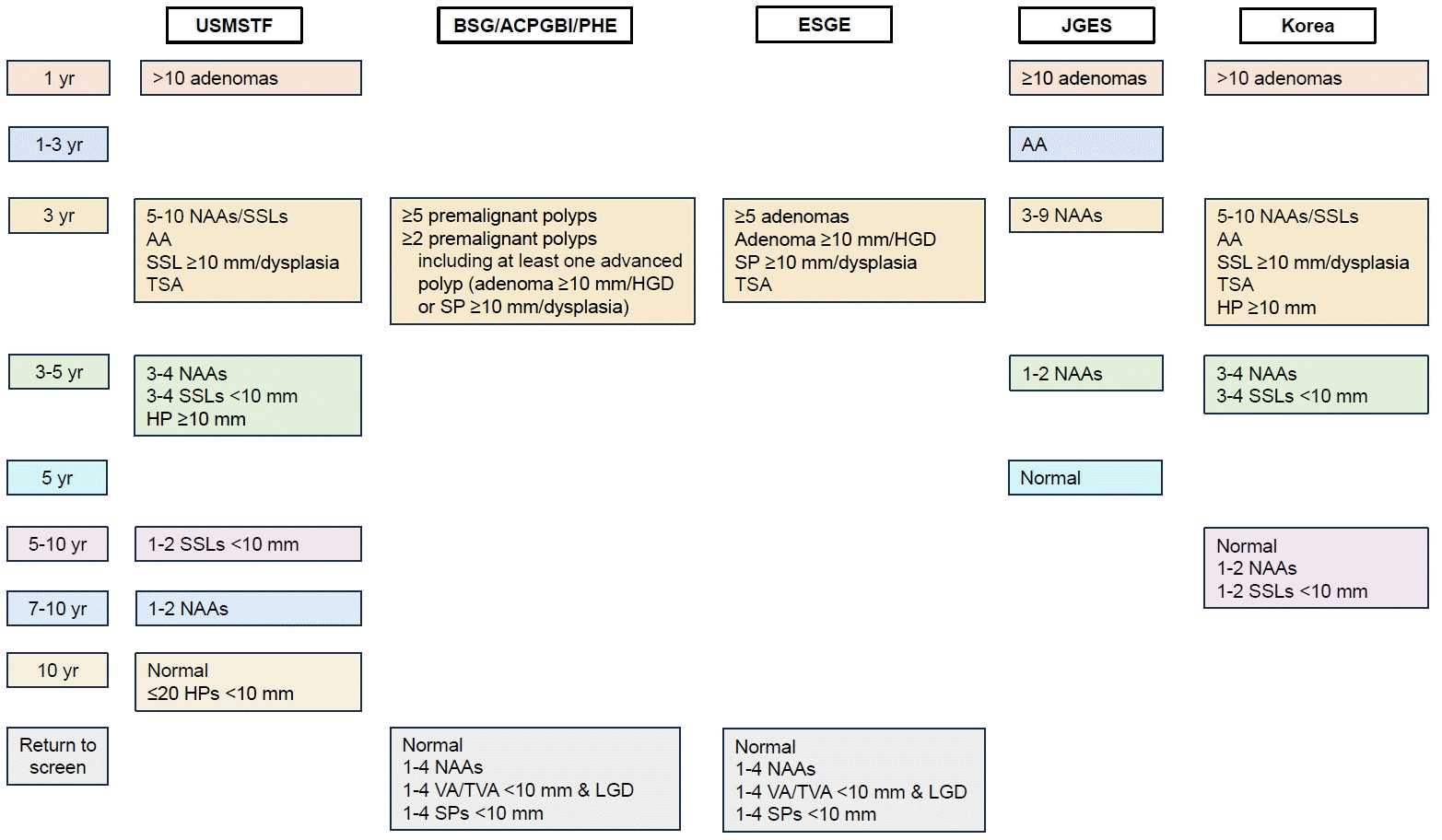INTRODUCTION
DEFINITIONS OF TERMS
SURVEILLANCE OF CONVENTIONAL ADENOMA
 | Fig. 1.Summary of main recommendations from the 5 guidelines. Advanced adenomas (AAs) refer to adenomas ≥10 mm in size or those with high-grade dysplasia or tubulovillous/villous histology. Nonadvanced adenomas (NAAs) refer to tubular adenomas <10 mm and with low-grade dysplasia. Serrated polyps (SPs) include hyperplastic polyps (HPs), sessile serrated lesions (SSLs), and traditional serrated adenomas (TSAs). USMSTF, U.S. Multi-Society Task Force; BSG, British Society of Gastroenterology; ACPGBI, Association of Coloproctology of Great Britain and Ireland; PHE, Public Health England; ESGE, European Society of Gastrointestinal Endoscopy; JGES, Japan Gastroenterological Endoscopy Society; HGD, high-grade dysplasia; VA, villous adenoma; TVA, tubulovillous adenoma; LGD, low-grade dysplasia. |
Table 1.
| Baseline colonoscopy finding | 2020 USMSTF | 2020 BSG/ACPGBI/PHE | 2020 ESGE | 2021JGES | 2022 Korea |
|---|---|---|---|---|---|
| 1–2 tubular adenomas < 10 mm | 7–10 yr | Return to screening | Return to screening | 3–5 yr | 5–10 yr |
| 3–4 tubular adenomas < 10 mm | 3–5 yr | Return to screening | Return to screening | 3 yr | 3–5 yr |
| 5–10 tubular adenomas < 10 mm | 3 yr | 3 yr | 3 yr | 3 yr | 3 yr |
| Adenoma ≥ 10 mm | 3 yr | 3 yra | 3 yr | 1–3 yr | 3 yr |
| Adenoma with high-grade dysplasia | 3 yr | 3 yra | 3 yr | 1–3 yr | 3 yr |
| Adenoma with villous histology < 10 mm | 3 yr | Return to screening | Return to screening | 1–3 yr | 3 yr |
| > 10 adenomas | 1 yr and consider genetic testing | Referred to BSG hereditary CRC guidelines (1–2 yr) | Genetic counseling | 1 yr | 1 yr and consider genetic testing |
| Piecemeal resection of adenoma > 20 mm | 6 mo | 2–6 mob | 3–6 mo | 6 mo | 6 mo |
a The BSG/ACPGBI/PHE recommends surveillance after 3 years in the presence of 2 or more precancerous polyps.
USMSTF, U.S. Multi-Society Task Force; BSG, British Society of Gastroenterology; ACPGBI, Association of Coloproctology of Great Britain and Ireland; PHE, Public Health England; ESGE, European Society of Gastrointestinal Endoscopy; JGES, Japan Gastroenterological Endoscopy Society; CRC, colorectal cancer.
1. Surveillance for 1–4 Tubular Adenomas <10 mm in Size and with LGD
2. Surveillance for 5–10 Adenomas
3. Surveillance for >10 Adenomas
4. Surveillance for Adenoma ≥10 mm or with HGD
5. Surveillance for Adenoma with Tubulovillous/Villous Histology
6. Piecemeal Resection of Adenoma >20 mm
SURVEILLANCE OF SP
Table 2.
| Baseline colonoscopy finding | 2020 USMSTF | 2020 BSG/ACPGBI/PHE | 2020 ESGE | 2021 JGESc | 2022 Korea |
|---|---|---|---|---|---|
| ≤ 20 HPs in rectum or sigmoid colon < 10 mm or ≤ 20 HPs proximal to sigmoid colon < 10 mm | 10 yr | No recommendation | No recommendation | No recommendation | No recommendation |
| HP > 10 mm | 3–5 yr | No recommendation | No recommendation | No recommendation | 3 yrd |
| 1–2 SSLs < 10 mm | 5–10 yr | Return to screening | Return to screening | No recommendation | 5–10 yr |
| 3–4 SSLs < 10 mm | 3–5 yr | Return to screening | Return to screening | No recommendation | 3–5 yr |
| 5–10 SSLs < 10 mm | 3 yr | 3 yr | No recommendation | No recommendation | 3 yr |
| SSL ≥ 10 mm | 3 yr | 3 yra | 3 yr | No recommendation | 3 yr |
| SSL with dysplasia | 3 yr | 3 yra | 3 yr | No recommendation | 3 yr |
| TSA | 3 yr | 3 yra | 3 yr | No recommendation | 3 yr |
| Piecemeal resection of SSL > 20 mm | 6 mo | 2–6 mob | 3–6 mo | No recommendation | 6 mo |
| SPS | No recommendation | Referred to BSG hereditary CRC guidelines (1–2 yr) | No recommendation | 1 yr | No recommendation |
a The BSG/ACPGBI/PHE recommends surveillance after 3 years in the presence of 2 or more precancerous polyps.
c The JGES proposes surveillance intervals of 3–5 years for SSL without considering size and number.
d The Korean guidelines recommend a 3-year surveillance interval for serrated polyps ≥10 mm regardless of whether they are HPs or SSLs.
USMSTF, U.S. Multi-Society Task Force; BSG, British Society of Gastroenterology; ACPGBI, Association of Coloproctology of Great Britain and Ireland; PHE, Public Health England; ESGE, European Society of Gastrointestinal Endoscopy; JGES, Japan Gastroenterological Endoscopy Society; HP, hyperplastic polyp; SSL, sessile serrated lesion; TSA, traditional serrated adenoma; SPS, serrated polyposis syndrome; CRC, colorectal cancer.




 PDF
PDF Citation
Citation Print
Print



 XML Download
XML Download